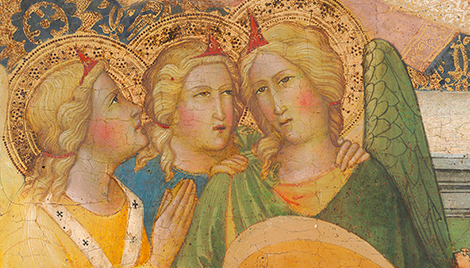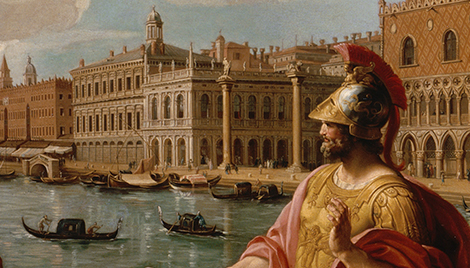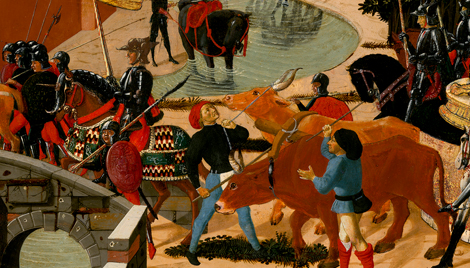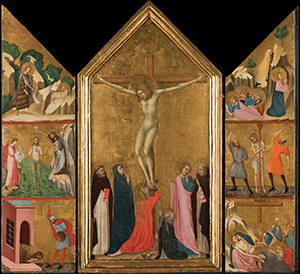The Crucifixion with Scenes from the Passion and the Life of Saint John
The Crucifixion with Scenes from the Passion and the Life of Saint John
- Artist
- Attributed to Lippo di Benivieni
- Artist Dates
- active 1296-1320
- Artist Nationality
- Italian
- Title
- The Crucifixion with Scenes from the Passion and the Life of Saint John
- Date
- c. 1315-20
- Medium
- tempera on panel
- Dimensions
- 72.4 x 78.1 x 7 cm (28-1/2 x 30-3/4 x 2-3/4 in); right panel: 62.9 × 16.5 cm (24-3/4 × 6-1/2 in); center panel: 64.8 × 34.3 cm (25-1/2 × 13-1/2 in); left panel: 64.8 × 17.5 cm (25-1/2 × 6-7/8 in)
- K Number
- K1430
- Repository
- Memphis Brooks Museum of Art
- Accession Number
- 61.201
- Notes
Provenance
Rev. Jarvis Holland Ash, Hungershall Park, Tunbridge Wells, England, 1880s. (Arthur Brentano, New York); sold to the Samuel H. Kress Foundation on 22 July 1947; gift 1961 to Memphis Brooks Museum of Art, no. MBMA 61.201.
Catalogue Entry
Attributed to Lippo di Benivieni
The Crucifixion with Scenes from the Passion and the Life of Saint John
K1430
Memphis, Tenn., Brooks Memorial Art Gallery (61.201), since 1958.(1) Wood. Middle panel, with moldings, 25 1/2 x 13 1/2 in. (64.8 x 34.3 cm.); left wing, 25 1/2 x 6 7/8 in. (54.8 x 17.5 cm.); right wing, 24 3/4 x 6 1/2 in. (62.9 x 16.5 cm.). Many losses of paint throughout, especially in the wings; gold background of middle panel new; cleaned 1950. This is stylistically related to two well-known panels of the Deposition, one in the Fogg Museum, Cambridge, Mass., the other in the Stoclet Collection, Brussels. The latter, especially, offers a close parallel in composition to the scene of the Deposition in K1430. The triptych is therefore related to the other two panels in the problem of attribution: the Fogg and Stoclet Depositions have been attributed to both the Florentine and the Sienese School.(2) All three paintings show the influence of the International Style. It is especially obvious in the curved pose of St. John in K1430's scene of the Baptism, such a pose as Ghiberti later (in the early 1400s) used most effectively in the same scene on his first doors of the Florentine Baptistry. We see it also in the miniature that Simone Martini painted in Petrarch's Virgil codex in the early 1340s. The date of K1430 would fall somewhere between these two. Provenance: Rev. Dr. Ash, Hungershall Park, Tunbridge Wells, England –exhibited: Royal Academy, 1879, no. 185, as Giottino.(3) Arthur Brentano, New York (bought in the 1880s; sold to the following). Kress acquisition, 1947 –exhibited: National Gallery of Art, Washington, D.C., 1951-55.(4)
References
(1) Catalogue by W. E. Suida, 1958, p. 18, as school of Giotto. (2) Most critics place them in the Florentine School; Berenson (Italian Pictures of the Renaissance, 1932, p. 9) gives them to Andrea di Bartolo. (3) The size noted by Graves (in A Century of Loan Exhibitions, vol. I, 1913, p. 423) for the triptych, 23 x 11 1/2 in., raises doubt as to reference to K1430 in this exhibition. (4) Paintings and Sculpture from the Kress Collection, 1951, p. 30 (catalogue by W. E. Suida), as school of Giotto.






